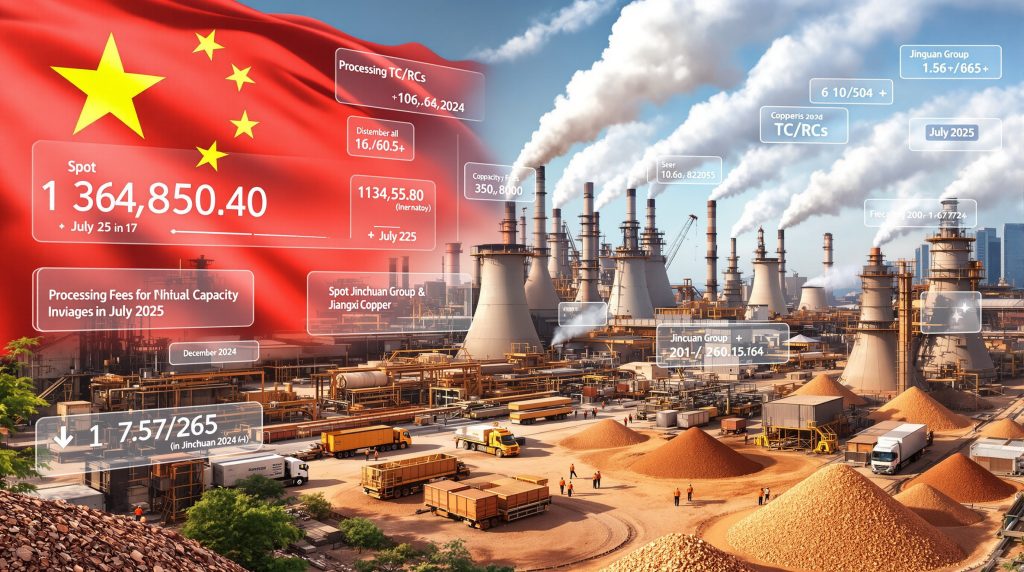## What Is Driving China’s Review of Copper Smelting Capacity?
China’s aggressive expansion in the copper smelting industry now demands robust oversight, as the need for China copper smelting capacity regulation becomes more urgent. In fact, this review is driven by market pressures and inefficiencies that jeopardise sustainable growth.
China’s rapid growth has led to major structural challenges that require careful intervention. For instance, many industry experts argue that continued expansion without coordinated oversight could threaten both profitability and long-term viability.
## Why Is Copper Smelting Capacity Under Scrutiny in China?
China’s copper smelting capacity has exploded over the past decade. As of 2025, Chinese firms account for more than half of global smelting operations by installed capacity. Consequently, the sector now faces intense “involutionary” competition where efficiency is sacrificed in the race for market share.
Many smelters have entered a race to the bottom by increasing output to claim a larger share, even while the supply of concentrate fails to keep pace. Moreover, these competitive practices have pressured processing fees to historic lows. For instance, some smelters have had to accept fees that mirror the trends seen in the Glencore smelter shutdown impact scenario.
## How Have Processing Fees for Copper Changed in 2025?
Treatment charges (TC) and refining charges (RC) are now at unprecedented lows. By the end of 2024, spot TC/RCs had fallen into negative territory. Consequently, it was not unusual for smelters in China to accept contract fees that defied historical trends.
When the processing fees turn negative, it means smelters effectively pay miners for processing services. Additionally, this situation underscores the risks of overcapacity and competitive distortions in the industry. Reports indicate that such trends may eventually contribute to a copper price collapse.
## What Unique Risks Are Associated With Overcapacity?
Overbuilding within China’s copper sector has produced multiple risks. Firstly, supply bottlenecks have arisen as new capacity vastly outstrips the increase in copper concentrate. Furthermore, upward pressure on resource costs has become prevalent as smelters bid higher for scarce raw inputs.
- Supply Bottlenecks: Intensified by rapid capacity expansion.
- Upward Resource Costs: As fees and raw concentrate prices rise.
- External Shocks: Examples include disruptions in Indonesian supply or policy changes abroad.
These risks create an environment where even minor logistical interruptions can cause significant issues. Moreover, tighter global regulation compels smelters to reconsider strategies in light of the global copper supply forecast.
## How Is the Chinese Government and Industry Responding?
Recognising the growing challenges, government and industry leaders are spearheading measures to rein in unchecked expansion. Their shared goal is to rebalance market forces and safeguard long-term sector stability.
Industry proposals now focus on a switch from destructive competition toward more sustainable practices. For instance, current reforms aim to curtail unsustainable credit expansion and enforce tighter control measures. Analysts also note that the recent policy announcements have led to noticeable market shifts, including china copper smelter action.
## What Proposals Are on the Table to Regulate Expansion?
The China Nonferrous Metals Industry Association has proposed measures to strictly control further capacity additions. Stakeholders have underlined the urgency of abandoning “involutionary” tactics.
In addition, proposals include eliminating disorderly price competition and introducing structured licensing. Industry experts further suggest that more responsible practices are needed to meet growing challenges. Analysts have shared copper price predictions that reinforce the need for a regulatory overhaul.
## Which Companies Are Leading Sector Discussions?
Major industry players are now actively participating in discussions on reform. Companies such as Jinchuan Group, Jiangxi Copper, and Tongling Nonferrous have voiced support for coordinated measures, while others like China Copper and Daye Nonferrous emphasise improved licensing and supply discipline.
Furthermore, giants including China Minmetals and Zijin Mining have joined the debate, signalling broad industry commitment. Their combined influence suggests that any regulation will be designed to serve the entire sector rather than being isolated to specific companies.
## How Have Markets Reacted to Policy Announcements?
The announcement of measures in July 2025 spurred optimistic reactions in several commodity markets. For example, markets such as lithium and coal experienced noticeable uplifts. However, the initial response in copper prices was muted as global investors adopted a cautious stance, wary of deep-rooted capacity issues.
In addition, external market events continue influencing price stability. For instance, forecasts by Freeport-McMoRan regarding lower Indonesian output nudged LME copper prices slightly upward, even as the situation reminded investors of the ongoing copper price collapse risk.
## What Broader Trends Shape This Regulatory Review?
The move towards tighter regulation is part of a larger government agenda. This includes supply-side structural reforms to address overcapacity and stabilise domestic industries. Moreover, the government aims to enhance global pricing power by reducing internal competitive pressures.
Key focus areas include:
- Supply-side reforms: Addressing overcapacity directly.
- Domestic industry stabilisation: Ensuring long-term sustainability.
- Global pricing improvement: Mitigating internal market distortions.
With surging copper demand driving market dynamics, there is a clear imperative for policy reform. Evidence suggests that robust regulation may improve contract stability and foster healthier market conditions, as seen in the context of surging copper demand.
## What Are the Short- and Long-Term Impacts of Smelting Capacity Controls?
The debate on capacity regulation is not restricted to domestic impacts. Instead, its ramifications extend throughout the global copper value chain. In the short term, smelters face pricing pressures and contract renegotiations, while the long-term impact could reshape global trade patterns.
For instance, as processing fees remain depressed, Chinese smelters are reconsidering supply contracts and pricing models. In addition, these changes might ultimately influence global market perceptions, thus benefiting broader industry forecasting and stability.
## How Might Supply Contracts and Global Trade Shift?
Ongoing revisions to supply chain protocols have led international markets to re-evaluate risk and profitability. Negotiations with major miners, such as Chile’s Antofagasta, are now being viewed through the lens of advancing regulations. Consequently, these developments could have lasting effects on trade agreements worldwide.
Furthermore, shifts in domestic policy have forced smelters to review their strategies. This has led some firms to adjust with a more forward-thinking approach and secure more consistent contractual terms, adapting to the new market realities.
## How Are International Events Affecting China’s Position?
External events are increasingly influencing China’s internal regulatory landscape. For example, market reactions to forecasts of lower mine outputs in Indonesia have pushed global copper prices upward. Such incidents remind us that the domestic reforms are taking place in an increasingly interconnected global economy.
In addition, industry experts argue that these external factors might accelerate the pace of regulatory change. Other countries’ policies and market movements may further compel China to maintain stricter oversight, especially when coupled with a move towards tightened smelter rules.
## FAQ: China Copper Smelting Capacity Regulation
### Why Is Overcapacity Such a Challenge for Copper Smelters?
When smelter expansion far outstrips the available mined copper, operating margins shrink dramatically. As a result, only the most efficient players can survive the competition for limited concentrate supplies, leading to severe market distortions.
### What Solutions Are Industry Leaders Considering?
Key solutions include:
- Halting new smelter construction projects.
- Introducing stricter government licensing for capacity expansion.
- Encouraging cooperative supply distribution to avoid destructive price wars.
### Could Regulation Improve Profitability or Market Stability?
Yes, if enforced effectively, regulation could eventually raise processing fees and stabilise the market. However, success requires consistent administrative enforcement and full industry alignment to prevent circumvention.
## Case Study: Impact of Involutionary Competition
### Scenario: Two Smelters in Fierce Rivalry?
Consider two competing smelters actively expanding to outdo each other. They invest heavily in capacity, hoping to secure a larger fraction of the available concentrate supply. Meanwhile, the competition drives processing fees ever lower, leaving both companies with razor-thin margins.
- Rivalry leads to unsustainably low fees.
- Financial stress limits capital upgrades.
- Both firms risk long-term sustainability due to this destructive cycle.
This scenario vividly illustrates why regulators are increasingly eyeing industry practices to stabilise the market.
## Conclusion: What Lies Ahead for China’s Copper Smelting Sector?
China copper smelting capacity regulation stands at a pivotal juncture. Policy measures under discussion seek to curb destructive competition while securing supply chains. Moving forward, industry stakeholders must align with national priorities to ensure a balanced market environment.
Furthermore, the success of China copper smelting capacity regulation will depend on effective enforcement and cooperation among major players. Ultimately, the evolution of these reforms will have far-reaching effects on global copper pricing and supply.
Overall, the future of the sector hinges on the ability to combine strict oversight with innovative industry responses. Only through such a balanced approach can deeper structural challenges be overcome, ensuring that the market not only survives but thrives amidst continuous global change.
Ready to Capitalise on Emerging Mineral Discoveries?
Discover the next major opportunity with Discovery Alert’s real-time notifications on ASX mineral discoveries, powered by the proprietary Discovery IQ model. Stay ahead in the market by exploring historic success stories and actionable investment insights at the Discovery Alert discoveries page now.




